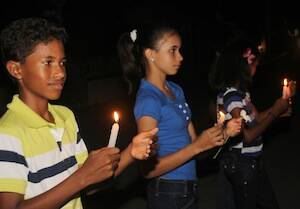Tonight we are breaking the silence,” said Regino Martínez, the Jesuit priest who is head of Solidaridad Fronteriza, a human rights and immigration organization in the Dominican Republic. “Tonight, we lose the fear.” On Oct. 4 he led a candlelight procession to the aptly named Massacre River on the border with Haiti in a commemoration of the 75th anniversary of the Parsley Massacre. During a five day period in early October 1937, Dominican soldiers slaughtered thousands of Haitians, many of them born in the Dominican Republic, under orders from the Dominican dictator Rafael Trujillo. Between 9,000 and 30,000 people died in the violence, a slaughter now largely forgotten. Haitians call it kout kouto-a, “the stabbing. “Dominicans refer to it as el corte, “the cutting.” It earned the nickname Parsley Massacre because some soldiers are said to have carried parsley sprigs. When they showed the parsley, victims were told to say the word. If people could not pronounce it in the Spanish way, they were killed.
'Parsley Massacre' Remembered
Show Comments (
)
Comments are automatically closed two weeks after an article's initial publication. See our comments policy for more.
The latest from america
Latin Mass, Eucharistic Revival, real presence: In every age—including our own—the church has seen a complex Eucharistic landscape.
A Homily for the Eighteenth Sunday in Ordinary Time, by Father Terrance Klein
Acceptance of changing tides was a major theme at the recent Conference of Major Superiors of Men National Assembly.
Catholic digital content creators reflect on their experiences at the Vatican's first-ever Jubilee of Digital Missionaries and Catholic Influencers.








